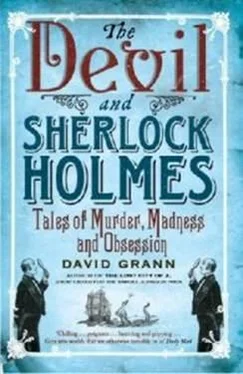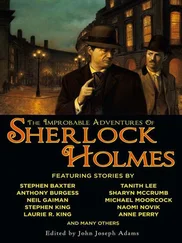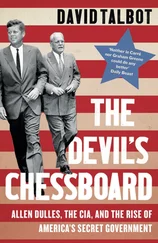But as his reputation for cleverness grew, so did his rap sheet. By his sixteenth birthday, it included charges of “breaking and entering” and “simple larceny.” After he escaped from reform school and fled to Georgia, he was sentenced to “be placed and confined at labor in the chain gang.” Like all new inmates, he was taken to the blacksmith, where a chain was riveted around both of his ankles. The steel gradually ate into the skin, a condition known as shackle poisoning.
“The guards would give you the first three days to let you get your hands broken in with calluses,” Tucker recalls. “But after that the walking boss would punish you, hit you with his cane or fist. And if you didn’t work hard enough the guards would take you in the bathroom and tie your hands behind your back and put a pressure hose in your face and hold it there until you’d sputter and you couldn’t breathe.”
Although Tucker was released after only six months, he was soon convicted again, for stealing another car, and sentenced to ten years. By now, “we see a man who has been thoroughly cast out by society,” Tucker’s lawyer later wrote in a court motion. “Marked as a criminal at seventeen years old and constantly railroaded through judicial proceedings without the benefit of counsel, Forrest Tucker was becoming an angry young man.” Tucker himself says, “The die was cast.” In photographs taken after he was paroled at the age of twenty-four, his hair is cut short and he has on a white T-shirt; his once slender arms are coiled with muscles. His eyes are piercing. People who knew him say that he was extraordinarily charismatic-that girls flocked around him-but they also noted a growing reservoir of anger. “I think he had this desperate need to show the world that he was somebody,” one of his relatives says.
At first, Tucker sought work playing the saxophone in big bands around Miami, and he seemed to have harbored ambitions of becoming another Glenn Miller. Nothing came of it, though, and, after a brief failed marriage, he put away his sax and got himself a gun.
The outlaw, in the American imagination, is a subject of romance-a “good” bad man, he is typically a master of escape, a crack shot, a ladies’ man. In 1915, when the police asked the train robber Frank Ryan why he did it, he replied, “Bad companions and dime novels. Jesse James was my favorite hero.”
When Tucker was growing up, during the Great Depression, the appeal of bank robbers, fuelled by widespread anger over defaults and foreclosures, was reaching its zenith. After the F.B.I. gunned down John Dillinger, in 1934, droves descended on the scene, mopping up his blood with their clothes. At least ten Hollywood films were devoted to Dillinger’s life; one of them exclaimed, “His Story Is Written in Bullets, Blood and Blondes!”
Because the holdup demands a public performance, it tends to draw a certain personality: bold, vainglorious, reckless. At the same time, most bank robbers know that the society that revels in their exploits will ultimately demand their elimination, by incarceration or death. “They’ll get me,” Pretty Boy Floyd once said. “Sooner or later, I’ll go down full of lead. That’s how it will end.”
Indeed, by the time Tucker set out to become an outlaw, in the late nineteen-forties, most of the legendary stickup men had already been gunned down. Still, he began to imitate their style, dressing in chalk-striped suits and two-tone shoes, and he would stand in front of a mirror, pointing a gun at his own reflection. Finally, on September 22, 1950, with a handkerchief tied over his face and a gun drawn in the style of Jesse James, he strode into a bank in Miami and made off with $1,278. A few days later, he went back to the same place, this time for the entire safe. He was apprehended as he was trying to crack it open with a blowtorch on the roadside.
His career seemed even more fleeting than that of most bank robbers, but in the county jail Tucker decided he was more than an ordinary stickup man. “It didn’t matter to me if they gave me five years, ten years, or life,” he says. “I was an escape artist.”
He searched the prison for what he called “the weak spot.” One day around Christmas, after weeks of looking, he began to moan in pain. The authorities rushed him to the hospital, where doctors removed his appendix. (“A small price to pay,” Tucker says.) While convalescing, still chained to his bed, he started to work on the shackles. He had taught himself how to pick a lock using almost anything-a pen, a paper clip, a piece of wire, nail clippers, a watch spring-and after a few minutes he walked out, unnoticed.
He made his way to California, where he went on a spree of robberies, hurtling over counters, pointing his gun, and declaring, “I mean business!” He wore bright checkered suits and sped away in a flamboyant getaway car with tubes along the sides. He even talked like a character in pulp fiction. “This is a stickup, girls,” he once said, according to witnesses. “I’ve got a gun. Be quiet and you won’t get hurt.”
Hoping to improve his take, Tucker began to cast about for a partner. “I didn’t want any nuts or rats,” he says, adding, “I’m from the old school.” In the end, he found an ex-con named Richard Bellew, a tall, handsome thief with a high I.Q. and wavy black hair. Like Tucker, Bellew modelled himself on the stickup men of the nineteen-thirties, and he ran with a stage dancer named Jet Blanca. But Tucker chose him for another reason: “He always let me count the dough.”
They began to hit one bank after another. After one heist, witnesses said the last thing they saw was a row of suits hanging in the back seat of the getaway car. The heists, which continued for two years, dominated the local headlines, often preempting coverage of the 1952 Presidential election and the McCarthy hearings. Tucker and Bellew were depicted as “armed men” who “terrorized” their “victims,” but also as “dramatically attired” “hold-up artists” who “expertly stripped” the tellers of cash, leaving behind “only an impression of competent banditry… and one getaway car.”
On March 20, 1953, more than two years after Tucker’s escape from the hospital, F.B.I. agents surrounded him as he was retrieving loot from a safe-deposit box in San Francisco. Then they went to search the place Tucker had listed as his residence. There, in a spacious apartment in San Mateo, they found a young blond woman who said she had never heard of Forrest Tucker. She was married to a wealthy songwriter, she said, who commuted daily to the city, and they had just moved into a bigger apartment to make room for their five-month-old son. Her husband’s name, she told the police, was Richard Bellew. Yet when the officers showed Shirley Bellew a photograph of the bank robber and longtime prison fugitive Forrest Tucker, she burst into tears. “I can’t believe it,” she said. “He was such a good man, such a good provider.”
She recalled how her husband would come home every night and play with their baby, whom they had named Rick Bellew, Jr. “What’s going to become of our little baby?” she asked. “What’s his name going to be?”
“Let me tell you about Alcatraz,” Tucker said one day as he sat in the corner of the visiting room, his walker resting against his leg. He had spread a napkin out in front of him and was eating a meatball hero I’d brought him and sipping a Dr Pepper. “There were only fifteen hundred and seventy-six people who ever went there. I was No. 1047.”
Alcatraz, or “the Rock,” had been converted from a military prison in 1934 as a way to confine the country’s most notorious criminals, including George (Machine Gun) Kelly, Robert Stroud (the Birdman of Alcatraz), and Mickey Cohen. At least half of the inmates had previously attempted to break out of other prisons. Surrounded by the freezing San Francisco Bay and its deadly currents, it was built to be escapeproof. Al Capone, who was sent there in 1934, is said to have told the warden, “It looks like Alcatraz has got me licked.”
Читать дальше











